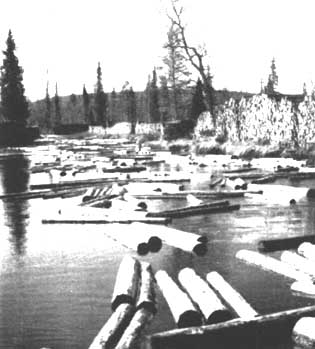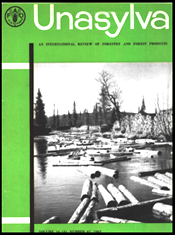

1962
Vol. 16 (4)
Unasylva - An international review of forestry and forest products
ANNUAL SUBSCRIPTION: U.S. $2.50 or 12s. 6d.
SINGLE COPY: U.S. $0.65 or as. 3d.
Rates can be paid in local currencies when orders are placed through the authorized sales agents listed on the back cover.
FAO - The Food and Agriculture Organization of the United Nations was founded at Quebec, Canada, in October 1945 when its member nations agreed to work together to secure a lasting peace through freedom from want. The Headquarters office of the Organization was located at Washington D.C., U.S.A., until 1951 when it was moved to Rome, Italy. The membership of FAO now stands at 101 nations with 3 associate members.
Unasylva - Started in 1947 by MARCEL LELOUP, first Director of the Forestry and Forest Products Division (present Director, EGON GLESINGER), this quarterly publication is intended to cover a range of interests which is as wide as that of the Division whose work it mirrors. Signed articles express the opinions of the authors and do not necessarily represent the views of the Organization. All material published in Unasylva may be freely reprinted but acknowledgment is requested, together with a copy of the publication which contains the reprint. Editor: LESLIE J. VERNELL.

COVER PHOTOGRAPH. Expressive of present-day paper needs are these stocks
alongside a floating stream in Finland. The key role given to education in the
developing countries of the world will result in a much larger demand for paper.
Increased consumption of paper will, however, require additional investments
in the printing and publishing industry. With UNESCO and the Swedish Institute
for International Economic Research, FAO is now investigating the problems involved.
(Photo, Metsäliitto, Helsinki)
This electronic document has been scanned using optical character recognition (OCR) software and careful manual recorrection. Even if the quality of digitalisation is high, the FAO declines all responsibility for any discrepancies that may exist between the present document and its original printed version.
Sir Henry Beresford-Peirse
The
evolution of forestry
Jack C. Westoby
Forest
industries in the attack on economic underdevelopment
Some aspects of development policy
The products of forest industries in the economy - present and future
Characteristics of forest industries
Characteristics of the forest base
Features of forest industries relevant to development
Resources, technology and research
Determining the role of forestry
Planning for forest industrial development
F. I. Cermak and A. H. Lloyd
Suplement
- Timber transportation in the tropics
I - Short distance or minor transportation
1. Manpower without equipment
2. Manpower with nonmechanical equipment
3. Minor transportation by animals
4. Mechanical traction
5. Self-propelled logging vehicles, crawler and wheeled tractors
6. High-lead yarding with portable sparsII - Long-distance or major transportation
7. Hauling by animal traction
8. Hauling by railroad
9. Hauling by truck, and by tractor with trailer
10. Timber transportation by waterIII - Transportation by water and air: loading timber
10. Timber transportation by water (concluded)
11. Timber transportation by helicopter
12. Loading timber by manpower or simple equipment
13. Loading by means of mechanical power
14. The future of tropical logging